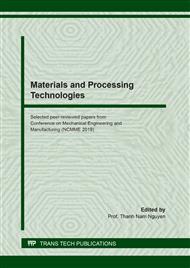p.33
p.51
p.59
p.67
p.73
p.79
p.85
p.97
p.103
A Study on Application of Ultrasonic Wave and Ozone Micro-Bubbles in Leafy Vegetables Washing
Abstract:
The demand for vegetable consumption is essential issue to serve citizens. Excessive protective chemical elimination which is applied advanced solutions brings high effects being investigated by domestic and international scientists. In this report, research team conducted and designed the vegetable washing machine integrated with the ultrasonic power and Ozone microbubbles to wash out plentiful protective chemicals attaching to surfaces of leafy vegetables. Followingly, using Taguchi method for four kinds of vegetables including salad, water spinach, Chinese cabbage, and mustard greens verifies the effectiveness of solutions. Vegetable samples are treated soaking pool making ultrasonic wave and Ozone microbubbles raging from 1.0ppm to 2.0ppm. The practical results demonstrated that the method using the ultrasonic power and Ozone microbubbles has high effects on eradicating protective chemical on leafy vegetables.
Info:
Periodical:
Pages:
79-84
Citation:
Online since:
September 2020
Authors:
Keywords:
Price:
Сopyright:
© 2020 Trans Tech Publications Ltd. All Rights Reserved
Share:
Citation:


